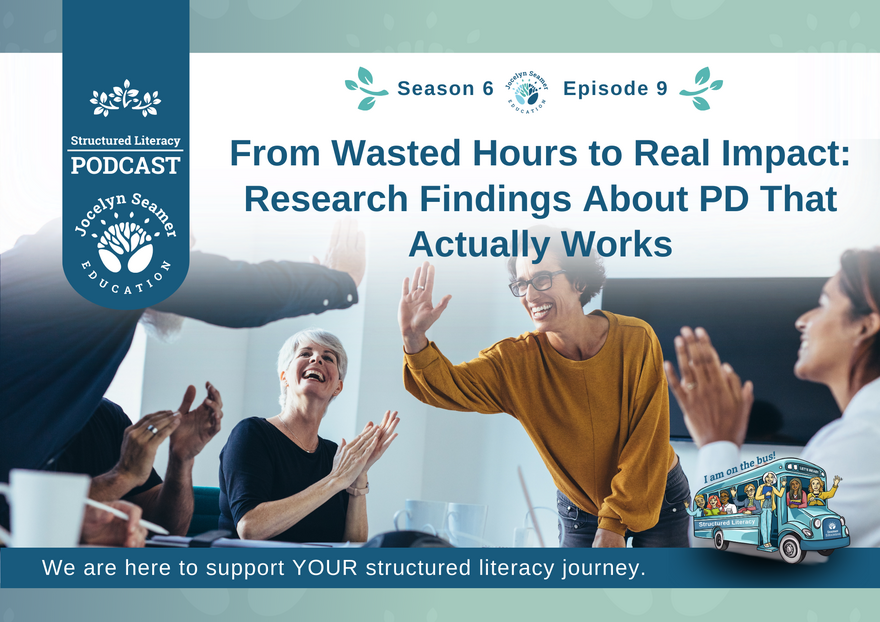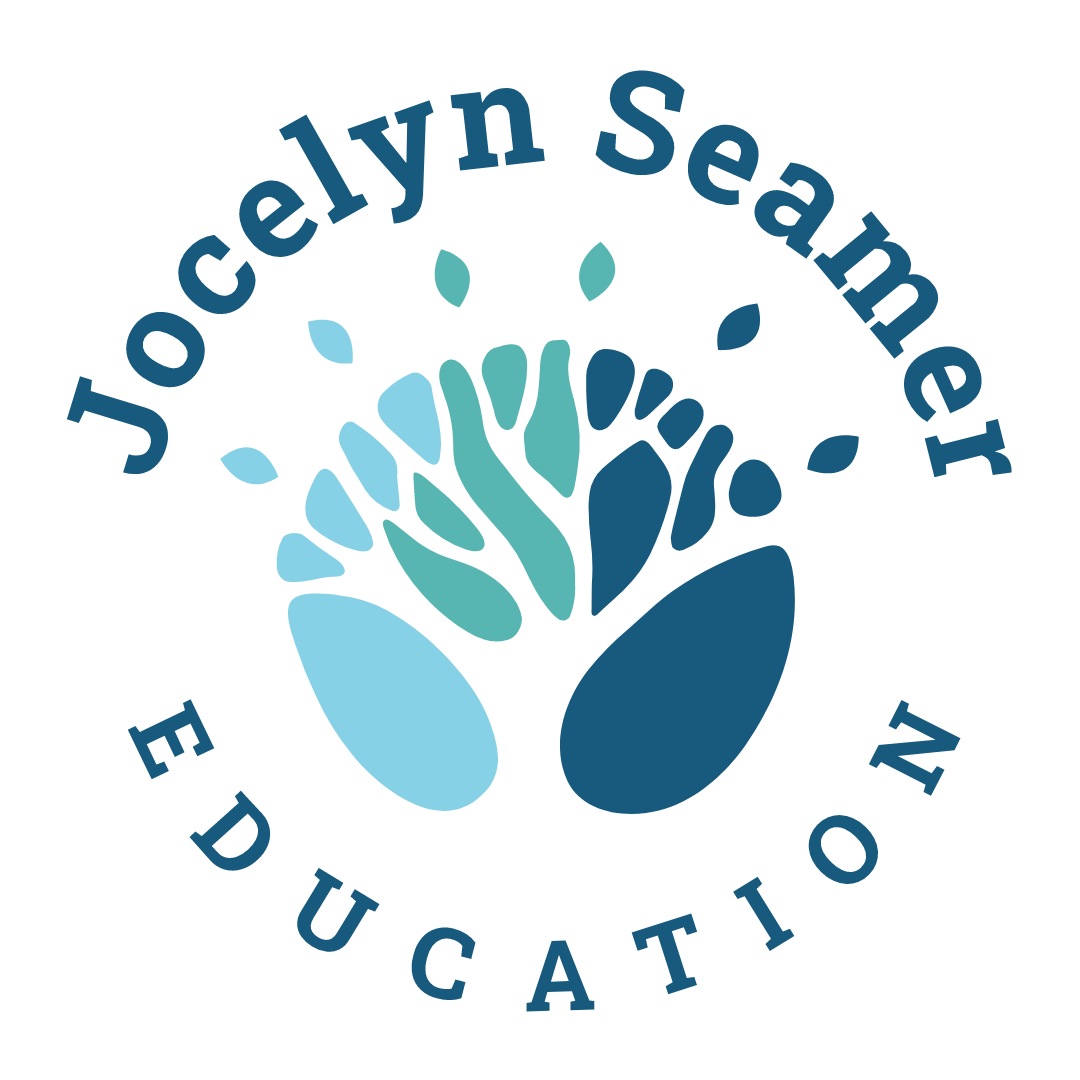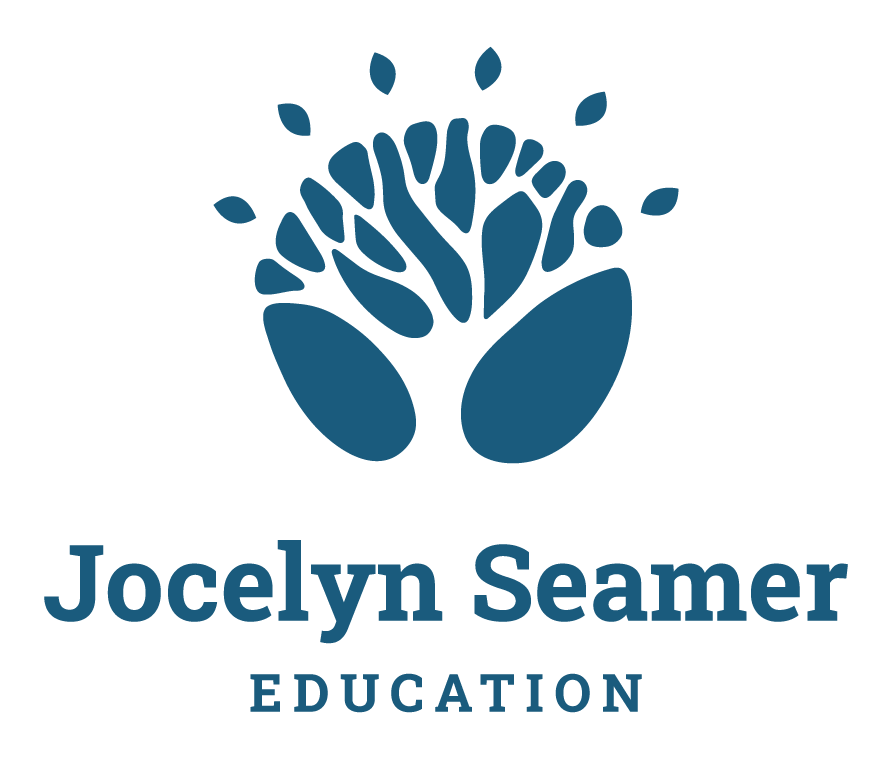S6 E9 - From Wasted Hours to Real Impact: Research on PD That Works

Well, hello there. Welcome to this episode of the Structured Literacy Podcast. I'm Jocelyn and I'm so pleased that you've joined me today. We're recording here in Tasmania, on the lands of the Palawa people. Today we're diving into something that affects every single teacher listening to this podcast: professional learning. If you've been listening for a couple of episodes now, you'll see that there's a theme, and there absolutely is. This issue is at the heart of it, because it doesn't matter how good the program is, it doesn't matter how good the lessons are, if we don't build the capacity of our teams, we're just not going to get the results we want. So, whether you're a classroom teacher attending yet another after-school session or a leader planning PD for your team, I know you've all experienced that full spectrum, from the transformative sessions that completely changed how you teach to those where you sat there thinking I could be doing any number of things in my classroom instead of being here.
And so what's the difference? Well, we can turn to research for some answers. What does research actually tell us about effective professional development and how can we, as professionals, make sure the time we invest in our learning, and the time we ask our teams to invest, actually leads to meaningful change in classrooms and better outcome for teachers. Those are the questions that we're going to try and answer in this podcast today. So let's explore what decades of research reveals about professional learning that truly works.
Let's be honest about where we've been.
For too long, professional development has looked like the one-off workshop, often delivered by someone who hasn't been in a classroom for years, focusing on that latest educational trend with little connection to your actual teaching context, followed by the expectation that you'll somehow transform practice overnight. And we have had an episode of the podcast talking about the difference between transactional and transformational PD. So if you haven't had a listen to that one, I recommend that you do.
Research consistently shows that this approach doesn't work. The Learning Policy Institute's comprehensive review of 35 rigorous studies found that traditional one-shot workshops produce minimal changes in teaching practice and virtually no improvement in student outcomes. The Education Endowment Foundation puts it simply, "Effective professional development must be structured professional learning that results in changes to teacher knowledge and practices and improvements in student learning outcomes." Notice both parts of that equation. It's not enough to feel good about a session or even to learn something new, the gold standard is actual change in what happens in classrooms.
So what does effective professional development that reflects research actually look like?
Well, there are seven key elements that consistently appear in successful professional development tasks or activities, and let me walk you through each one of them.
First up, we have a focus on content.
Effective professional development focuses on teaching strategies associated with specific curriculum content. This means we have to move beyond generic teaching tips to deep, subject-specific pedagogy. When teachers learn within their actual teaching context, whether that's early literacy, maths or science, they can immediately see how what they're learning applies to their students. I work with a number of schools, and some of them are P to 12 schools, and often there will be requests that the professional development is for the entire school and while there are benefits of this, in some instances, it is impossible to deliver relevant content-focused professional development when you have such a massive spread. It's hard enough for the primary school, let alone for the entire school, across the Preschool to 12. So something to think about for those of us who are leading in those sorts of contexts. The most effective programs ground their content in robust theories of how learning occurs. So, for example, professional development focused on reading instruction might be built on foundational cognitive science research, information processing theory to understand how students receive and retain information, cognitive load theory to manage the demands on working memory, and explicit teaching models and explicit teaching all align with how the brain actually learns.
The second factor is active learning.
Just as we know, students learn through hands-on experiences, teachers need opportunities to actively engage with the new content. It's not enough to talk about it or read about it, we actually have to do it. And this might mean analysing student work samples, practising new techniques or working through curriculum materials as learners themselves. It also includes having the opportunity to try things out for real with the students, to reflect on that attempt and come back and talk with colleagues. Effective programs ensure teachers participate in the same style of learning they'll be designing for their students. I don't think there's any better way to create an Aha! moment for a teacher than to put them in their students' shoes. So teachers might use practices like think-pair-share or text annotation, and they might use metacognitive strategies during their own learning. This can be followed up with work with real scenarios from actual teaching contexts and reflections about their own classroom.
The third factor that research has identified is collaboration.
And we've just had a whole podcast episode about collaborative professional learning that's done with people and not to them. High quality professional development creates space for teachers to share ideas and learn together, often in those job embedded contexts, and it's not just about feeling supported. Collaboration actually changes the culture of entire teams and schools. When teachers work together on common problems, when they use shared language and approaches, when they build shared vision, their impact extends far beyond individual classrooms, and you may have heard of the term collective efficacy. This might happen through whole staff learning sessions that build shared understanding, team-based work within existing professional learning communities, collaborative reflection on practice or cross-school networking opportunities that foster peer learning. So there can be something really terrific about having a Year Two teacher reflecting with a Year Six teacher on the application of the information processing model, because having to really explain your own context and your own thinking pushes us to a place of greater involvement in the work.
Fourth, we need models and modelling.
So teachers need to see what good practice looks like. This might include lesson plans, some student samples, peer observations and a range of other things, but I think that there's nothing that quite beats seeing modelling happening in your own classroom, and this is certainly a key factor for schools who are using our curriculum resources as their school's chosen approach. Seeing someone model it and then being able to debrief and connect that to what they're seeing in their data is a powerful lever for helping teachers to understand what they're looking at. The key is providing clear visions of best practice that teachers can adapt to their own context. That is, once they've learned about what makes the practices robust. But I keep talking about it, and I'll continue to talk about it, that we need to be able to adjust instruction to meet the needs of our students. So being able to see someone else teach, particularly if that person is highly skilled, and then being able to use that example to make suitable adjustments to their own practice for their own students, is really wonderful.
Fifth, we have coaching and expert support.
Now here's where the research gets really interesting. Studies consistently show that coaching, or expert scaffolding, can support the effective implementation of new curriculum tools and approaches, and this isn't just nice to have support, it is the missing link between learning something new and actually implementing it effectively in the classroom. It's also the hardest to resource, and I don't mean resource as in just dollars, but I mean to find the people who are able to do this work well. So that's a challenge, but not one that can't be overcome. Joyce and Showers describe coaching as the missing piece that helps professional learning transfer to actual classroom practice, and if you've been a listener of the podcast for a while, you will have heard me speak about their research. This support might take various forms, there could be one-on-one coaching in classrooms, group workshop facilitation and even remote mentoring using an online platform.
The key is sharing expertise about both content and practice, focused directly on teachers' individual needs. Just as we do not have one size fits all in the classroom, we don't have one size fits all in our teaching teams. We're all at different points in our experience and understanding, and the response from leaders needs to reflect that. So effective programs build the skills and knowledge of the leadership teams and the instructional coaches, providing them with frameworks to identify where each teacher sits developmentally and the tools to facilitate quality coaching conversations. So it's not just about helping teachers to grow, we also need to help build the capacity and the confidence of our leaders, and if we don't get that balance right, then we may not see those outcomes.
The sixth area is feedback and reflection.
So the research shows that effective professional development builds in time for teachers to think about, receive input on and refine their practice, and this might happen through analysing lesson observations, through reviewing videos, through talking with the teacher and discussing data. The key is creating systematic opportunities for reflection and improvement. Now I hear what you're saying, I'm sure that you're at least thinking, "Jocelyn, that's all very nice, but don't you know how busy we are?" And yes, I do. So, the key here to holding space for this is not to try and do it through the addition of extra meetings. It's looking at your existing structures. Many schools already have PLC or PLT structures within the school. That can be improved and you can build on what you already have. Often, with a few tweaks, with some different kinds of questions and structures, you can increase the effectiveness of that time to help teachers in their development. The most successful programs build in structured reflection protocols, and the PLC and PLT time is where the easiest opportunity is to apply those. Perhaps teachers analyse with their colleagues, they evaluate experiences, they discuss, they draw out the knowledge and experience of more experienced practitioners to help support. We're able to support each other, and an instructional coach who's sufficiently trained and has the knowledge to do so can use that opportunity as a teachable moment for the teachers around them.
Seventh is sustained duration, and this is perhaps the most important finding of all.
Effective professional development happens over weeks, months and even years, not in one-off sessions. Teachers need adequate time to learn, practise, implement and reflect on the new strategies that facilitate real changes in their practice. Sometimes that means you need the time to make mistakes. You need the time to celebrate the wins that you get, but sometimes you don't really know something until you've tried it out yourself and it didn't work, and then you say, ok, now I accept what they're telling me, that didn't work, and I'm sure that we've all been there.
This could look like programs operating across a full school year or more, with multiple pathways, having comprehensive planning meetings, regular staff sessions, ongoing team-focused learning, coaching sessions for leaders and continuous support that includes retrieval of core content during everyday work. And if you're thinking, this sounds a little bit like how we run our classrooms, yes, yes, it does. Research shows that when professional development incorporates most or all of these elements, it produces measurable improvements in both teaching practice and student outcomes. After all, if we're not seeing student outcomes, we don't have effective teacher development.
So how do we apply all of this research into our own context?
First, when you're attending professional learning or weighing up professional learning opportunities, look for these seven elements. We're putting the link to the papers that we've referenced here in the show notes so you can find that open access and have a look at that for yourself. If the elements are missing, well, advocate for them, ask the question. The research indicates that we need sustained duration, what will that look like for this learning? Ask for the follow-up sessions, request coaching support or organise peer collaboration to fill the gaps where you can. Second, if you're leading professional learning in your school, design with the elements in mind, use them as a bit of a checklist, and this might mean fewer topics covered more deeply, with more time for practice and reflection and ongoing support rather than one-shot sessions. And I know that Mildred is very loud when she's telling you that you're not doing enough, but sometimes you have to slow down to go further.
If you do bring a consultant in to deliver the same recycled presentation they've delivered 10 times before with no follow-up and no personalisation, the chances that the work will lead to lasting change are low. You would be better off investing that money in support for leaders to build their capacity in the space than you would be in having someone come in as a one-off. Because even the best designed professional development can fail if implementation barriers exist. So we need to make sure that we've got the conditions right for the learning to happen. If we have inadequate resources, such as time resources, we haven't set enough time aside and I'm sorry, but one literacy session a semester because our PL calendar is full of whole school meetings is not going to get you where you want to go.
So it's a little bit of tough love on this one. If we don't have the time devoted to the actual learning, well, we shouldn't be surprised if we don't get the outcomes that we want. The same goes for shared vision. If we don't all know what we're looking for, if we don't know what success looks like, if we're all operating with different ideas of what strong practice is, we're not going to get where we want to go. If we have a dysfunctional school culture where there's a lack of trust, where we can't have open conversations, where there are political decisions made, and when I say political I mean decisions we make because other people are watching, not because they're the right decision to make to get the outcome, then those things are all barriers to us having effective professional development. And finally, on this point, your principal needs to be the driver of the improvement agenda. Principals have to be at the heart of instruction. They have to know why they're doing what they're doing so that they can enable and lead the team in the work.
Leading Learning Success
And all of this research has directly informed how we've designed Leading Learning Success. Now, this is a program that I've created that operates across a full school year at minimum, with multiple pathways, incorporating evidence-based content grounded in the cognitive sciences. We embed practice within schools' existing contexts. We help schools achieve their strategic goals, not add more goals onto their plate. We support collaboration through existing PLC structures, provide coaching for instructional leaders and build internal capacity for sustainability. There's no point in doing the work if we're not building capacity of leadership to be able to take that work forward, doesn't help us to be dependent on someone from outside in the long term. We've structured the program specifically to address the partnership factors research shows are critical for success: strong principal-provider relationships, clear communication, school-level control (and that's an important one) and sustained support.
If Leading Learning Success is something that you think you might like to pursue, you can visit our website jocelynseamereducation.com, click on Professional Learning and you will find information about it there.
The bottom line for all of us, regardless of which path we choose for professional development, is that we know what it looks like to get it right. The research is pretty clear and consistent. The question isn't whether we can improve professional learning, it's whether we're willing to stand up and demand better for our schools and for our teachers, to just say no to the one-off, to be aligned with our strategic vision and our goals for our students, and to work with our teams in a way that's meaningful and long-lasting. Your time and your team's time is precious. Make sure it's being invested in professional learning that truly leads to professional development, which is all grounded in action in the classroom. That is what's going to get you improved outcomes for every student you serve.
Until next time, that's all from me. Happy teaching everyone. Bye.
Show Notes:
S6 E7 - Is Your PL Transformative or Transactional?
S6 E8 - From Compliance to Commitment: Transforming School Improvement
Darling-Hammond, L., Hyler, M. E., & Gardner, M. (2017). Effective teacher professional development. Learning Policy Institute. https://learningpolicyinstitute.org/product/teacher-prof-dev
Education Endowment Foundation. (2021). Effective professional development: Guidance report. https://educationendowmentfoundation.org.uk/education-evidence/guidance-reports/effective-professional-development
Joyce, B., & Showers, B. (2002). Student achievement through staff development (3rd ed.). Association for Supervision and Curriculum Development.
Zwiers, L. M. (2013). Making a good match: How schools and external service providers negotiate needs and services in support of school improvement [Doctoral dissertation, University of California, Berkeley]. ProQuest Dissertations Publishing.
If you'd like to find out more about our research-informed professional learning, click here.


 Jocelyn Seamer Education
Jocelyn Seamer Education
0 comments
Leave a comment